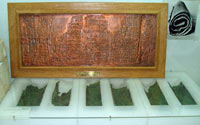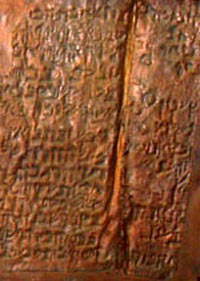Copper Dead Sea Scroll Displayed for the First Time in America
The famous Copper Dead Sea Scroll that has been intriguing man for decades is on display for the first time in the United States this month at the San Diego Natural History Museum.
Discovered in 11 caves between 1947 and 1952 near the Dead Sea in Israel's Khirbet Qumran, the Dead Sea Scrolls consist of thousands of fragments that were discovered and pieced together into over 900 separate documents. Most were created from parchment and papyrus reed, but the Copper Scroll is considered one of the greatest pieces of copper-archeological finds, and the most interesting.
 Copper Dead Sea Scroll, on display for the first time in the United States
Copper Dead Sea Scroll, on display for the first time in the United StatesBoth photos courtesy of the San Diego Museum of Natural History
 Copper Dead Sea Scroll, detail
Copper Dead Sea Scroll, detailThe Copper Scroll, comprised of thin sheets of bronze written in Hebrew with approximately 20 percent in Aramaic, has garnered much attention. And now, the San Diego Natural History Museum has an exhibition of the scrolls from Israel and Jordan, including ten scrolls that have never been displayed, beginning June 29. However, it's the section of the Copper Scroll, from Jordan, that is piquing the interest of archaeologists and artists worldwide, like a treasure hunt yet to be solved.
"The Copper Scroll was discovered in 1952 in Cave 3," explains Dr. Risa Levitt Kohn, Director of the Jewish Studies Program at San Diego State University, biblical scholar, and curator of this show. "When it was first discovered it looked as though it was two scrolls, but when excavated it was one long scroll rolled up into two rolls. It became clear that unrolling it would be impossible because it was so fragile it would probably break apart. In 1955 and 1956 it was transported to Manchester, England where it was cut into slices, or small sections, to be photographed and deciphered. Once it was cut open, it was discovered it was approximately eight feet long, one millimeter thick and 99% copper, and that metal workers (engravers) literally hammered the text into the copper using some kind of striking instrument."
According to Dr. Kohn, once deciphered, the scroll read in several different columns that comprised 64 cryptic locations where over 100 tons of gold, silver and other valuables were supposedly hidden. It stated directions like 'in the cistern that's in Beit Ha-Keren', or 'in a water tank at the valley of (blank)'. And, many theories exist of what this list might be.
"Perhaps the list is the contents of the treasury that belonged to the Jerusalem Temple before 70 C.E., or perhaps the possessions of the Qumran community, or, perhaps, it's legendary and never meant to be taken seriously," says Dr. Kohn. "The truth is, nobody really knows."
But, we do know the importance of this Copper Scroll.
"This is the first time that the Copper Scroll has been shown in the United States," says Delle Willett, Director of Marketing. "Our president, Dr. Michael Hager, negotiated with authorities from Jordan and Israel so the Copper Scroll can be displayed in the same room as the Dead Sea Scrolls."
To ensure preservation of the ancient scrolls, the Israel Antiquities Authority only allows scrolls to be exhibited for a three-month period. The museum has been granted the unusual opportunity for a six-month exhibition with 12 scrolls displayed for the first three months and an additional 12 in the last three months. Three other Dead Sea Scrolls from Jordan will also be on display throughout the course of the exhibition.
Resources:
Also in this Issue:
- Reflections of the Past: The Resurgence of the Copper Canvas
- Chelsea Stone Livens Up Her Jewelry Designs with Copper
- Coppersmithing in New Bedford
- Copper Dead Sea Scroll Displayed for the First Time in America
- Sotheby's Sets New World Record for Bronze Sculpture at Auction: Artemis and the Stag Fetches $28.6 Million
